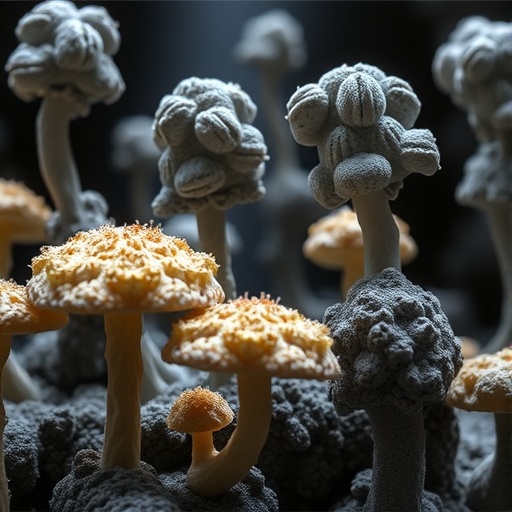In a groundbreaking study that bridges the realms of biology, chemistry, and material science, researchers have made significant strides in understanding how nanomaterials impact the production of cellulase enzymes by specific fungal species. The study focuses on two types of fungi, Aspergillus costaricensis and Trichoderma parareesei, both of which have shown immense potential in biotechnological applications. The research not only highlights the enzyme production capabilities of these fungi but also opens up new pathways for optimizing cellulase activity through the innovative application of nanotechnology.
Cellulases are a class of enzymes that play a critical role in the breakdown of cellulose—an abundant organic polymer found in plant cell walls. The ability to efficiently convert cellulose into fermentable sugars has significant implications, especially for the biofuel industry, where the demand for sustainable energy sources continues to grow. The research conducted by Elyamany et al. delves deep into how the introduction of nanomaterials can enhance the activity of these vital enzymes, thus improving overall cellulose degradation processes.
Nanomaterials—structures typically ranging from 1 to 100 nanometers in size—possess unique physicochemical properties that can enhance enzyme activities. Their high surface area to volume ratio allows them to interact more effectively with biological molecules, increasing the likelihood of catalytic action. In the context of cellulase production, the study explores various types of nanomaterials, including metallic nanoparticles, carbon-based nanomaterials, and silica nanoparticles, and their specific roles in influencing fungal metabolism and enzyme synthesis.
The research emphasizes the importance of selecting the right kind of nanomaterials. Different nanoparticles exhibit varied interactions with biological systems. For instance, certain metal nanoparticles can induce oxidative stress in fungi, leading to enhanced enzyme production. Alternatively, carbon-based nanomaterials may promote more stable enzyme structures, improving their efficacy in hydrolyzing cellulose into simpler sugars. This nuanced understanding of nanomaterial behavior in biological contexts is critical for optimizing enzyme production.
To evaluate the effects of these nanomaterials on the cellulase enzymes secreted by Aspergillus costaricensis and Trichoderma parareesei, the researchers designed a series of experiments. They cultivated the fungi on rice husk, a commonly available agricultural waste product, which serves as an ideal substrate for studying cellulase activity. The choice of rice husk not only adds an environmentally friendly element to the study but also demonstrates the practical applications of the research in bioprocessing and waste management.
The experiments revealed that certain concentrations of nanomaterials significantly boosted cellulase activity in both fungal species. The results indicate that enhancements in enzyme production and activity can be finely tuned by altering the types and concentrations of nanomaterials used during cultivation. This finding could have far-reaching implications for the industrial production of biofuels and biochemicals, where increased efficiency and reduced costs are paramount.
Moreover, the study shows that the interaction between nanomaterials and fungal organisms can trigger biological responses that exceed those of traditional cultivation methods. For example, the presence of specific nanoparticles prompted the fungi to express a higher number of genes associated with cellulase production. This genetic response could lead to a more abundant and potent enzyme profile, thus driving down the costs associated with enzyme extraction and purification.
Another significant aspect of this research is its potential contribution to a circular economy. By utilizing agricultural waste as a substrate and enhancing enzyme production through nanotechnology, the study lays the groundwork for sustainable bioprocessing strategies. Such approaches not only minimize waste but also capitalize on renewable resources, all while providing efficient solutions for energy production and material processing.
Furthermore, as the global community grapples with the dual challenges of energy demands and environmental sustainability, this research displays the vital intersection of nanotechnology and microbiology. The implications of effectively harnessing fungal enzymes in conjunction with nanomaterials extend to various industries, including textiles, food processing, and biodegradable plastics. This cross-disciplinary synergy could pave the way for innovative solutions to longstanding industrial challenges.
The study also prompts further investigations into the safety and scalability of using nanomaterials in biotechnological applications. The biological impact of nanoparticles on living organisms remains an area of intense research, and understanding the toxicological aspects of these materials is essential for their widespread adoption. Future studies will need to explore these dimensions to ensure that the benefits of nanotechnology do not come at the expense of ecological or human health.
In conclusion, the compelling findings presented by Elyamany et al. represent a significant leap forward in biotechnological research. The intricate relationship between nanomaterials and cellular enzymatic activity opens a new frontier in enzyme technology, promising more efficient and sustainable methods for biomass conversion and waste utilization. This research not only enriches the scientific discourse but also signals a transformative potential for industries reliant on cellulose degradation.
As we continue to explore the untapped possibilities of nanotechnology in biological systems, the integration of these cutting-edge materials with traditional processes could redefine our approach to bioprocessing. In summary, the collaborative effort between microbiology and nanotechnology can reshape the future of energy production and environmental sustainability, inspiring further investigations that pave the way for a greener planet.
Subject of Research: The effect of nanomaterials on cellulase enzyme production by fungi.
Article Title: Effect of nanomaterials on cellulase enzyme produced by Aspergillus costaricensis and Trichoderma parareesei grown on rice husk.
Article References: Elyamany, B.G., Ibrahim, A.H., Beheary, M.S. et al. Effect of nanomaterials on cellulase enzyme produced by Aspergillus costaricensis and Trichoderma parareesei grown on rice husk. Int Microbiol (2025). https://doi.org/10.1007/s10123-025-00714-y
Image Credits: AI Generated
DOI: https://doi.org/10.1007/s10123-025-00714-y
Keywords: Nanomaterials, cellulase, Aspergillus costaricensis, Trichoderma parareesei, rice husk, enzyme production, biotechnology, biofuels, sustainability.
Tags: Aspergillus costaricensis cellulase productionbiotechnological applications of fungicellulose to fermentable sugars conversionenhancing cellulose degradation with nanomaterialsenzyme activity enhancement in biofuelsfungal cellulase research advancementsnanomaterials and cellulase interactionnanomaterials in enzyme engineeringnanotechnology in biocatalysisphysicochemical properties of nanomaterialssustainable biofuel production with cellulasesTrichoderma parareesei enzyme optimization






